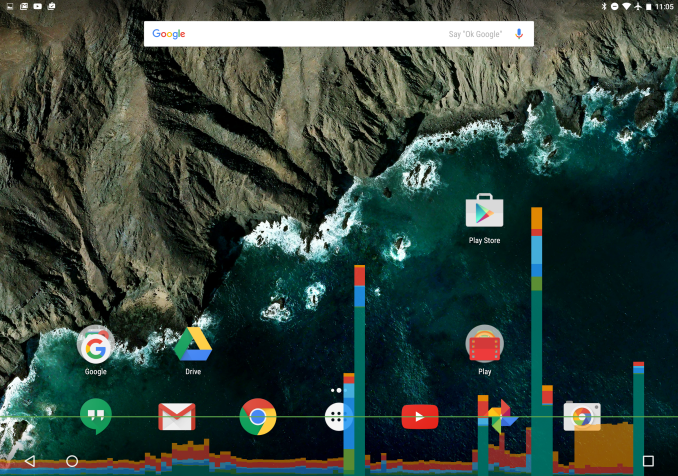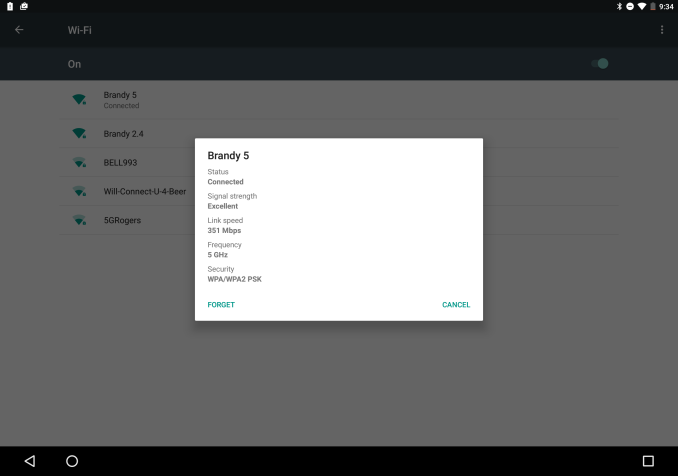Revisiting The Google Pixel C - Better, But Not There Yet
by Brandon Chester on February 17, 2016 8:01 AM ESTFinal Words
After taking in this new information, I suppose that the final question is whether or not my original verdict about the Pixel C still stands. That's a complicated question to answer, as the update from Google has addressed many, but not all of the issues I experienced with the original. I suppose it's worth doing a recap of what has and hasn't changed before deciding if this changes things for the Pixel C.
The most significant improvement with the updated firmware from Google is the fix for broken touch input. I really cannot overstate just how broken touch is on the Pixel C with its original shipping firmware, and the updated version feels like a completely different device. It's honestly like moving from a resistive touch display to a modern capacitive touch display, and even then, one could argue that resistive touch displays only had some of the problems that the Pixel C initially had. I think it's safe to say that this issue with the Pixel C is completely resolved, and that's a huge step toward making it a tablet that is worthy of commanding its $500 price.
The Pixel C drops fewer frames now than on the original firmware
On top of the fixes to touch input, the new software build has addressed a number of problems relating to performance and stability. I'm no longer experiencing frequent app and OS crashes, and in general there's far fewer stutters and slowdowns throughout the UI. Unfortunately, things aren't perfect. I still can't run our GPU battery test, which is really disappointing for Tegra X1's mobile debut. PCMark's battery test doesn't work for me either, even with the public version from Google Play. The test runs for some period of time, but eventually crashes, and I simply can't keep running it in the hopes that one run will eventually make it through. There are also a lot of applications that are just janky, including Google's Calendar app, and of course the eternally problematic Google Play and Google Chrome.
Chrome in particular is really bad regarding responsiveness and latency, and as far as web browsing goes it honestly feels like going back to something like an iPad 2 after the past five years of iOS updates have taken their toll on its responsiveness and performance. I have a feeling that Google is well aware of Chrome's problems, and I'm hopeful that they're something we'll see addressed in the near future, but for now you're really not getting the web browsing experience that a $500 device should provide.
As far as connectivity goes, I haven't seen improvements to the problems I experienced, which is disappointing. While I never had issues keeping connected with my home WiFi, the speeds and reception haven't been very good. I'm unable to maintain a signal at any appreciable distance, even when other smaller devices keep connected. Google tells me that poor antenna performance on 2.4GHz networks is a known issue, but 2.4GHz should be used as a fallback for when 5GHz can't provide sufficient range so that defeats the purpose entirely. Both Josh and I have also run into situations where the link rate drops below 400Mbps even when right beside the router, which is less than half of what it should be for a 2x2 802.11ac device.
In the end, Google's fixes to the Pixel C's software have done a lot to address the issues I noted in the original review. Its gone from being a tablet that I could not possibly recommend to anyone, to potentially being the best Android tablet you can buy. Unfortunately that's not a high bar to clear, but it's still a great improvement over the Pixel C with its original firmware. I still think I would forgo the keyboard, as Android just doesn't work well with it, and there aren't nearly enough tablet-focused applications to use it with to justify the additional cost.
I'm still reluctant to recommend high priced Android tablets due to the application situation, along with continued issues relating to input latency, multitasking, and gestures. However, if you really need something running Android then the Pixel C is an obvious option to consider. At the very least, the Pixel C is greatly improved with its new firmware. Once that happens I'll feel comfortable recommending the Pixel C provided you're okay with Android's general lack of tablet apps, and that's something that I certainly couldn't have said before.












67 Comments
View All Comments
andy o - Thursday, February 18, 2016 - link
Thanks for checking. I'm surprised that Skype even showed the BT option. I don't have that many problems with Bluetooth on other Android devices though. I've used every Nexus phone since the N4 (except the N5X), and AFAIK Google finally raised the bitpool for A2DP I think in KitKat or Lollipop. My only gripe had been inconsistent support for HFP 1.6 with wideband audio, which Nexus phones only got in the N6, and no Google tablet has ever had it. The Shield tablet also doesn't have it. That might be one of your sources of poor audio quality, btw, at least for calls.Tomnokoe - Wednesday, February 17, 2016 - link
Brandon, thank you so much for re-opening the Android touch latency issues. I feel like it's a point many people miss. The fluidity of the OS just isn't there. It's such a heavy thing to laden a smartphone with. Once noticed, it is almost impossible to ignore. The original iPad has better a better touch experience.yuanzhoulv - Wednesday, February 17, 2016 - link
As good as Google is with software, I do think a lot of their hardware is rather spotty and subpar. My Nexus 10, for example, would often just simply not charge, even left plugged in for 10+ hours straight. What gives? FWIW the tablet is useless now because I can never tell whether it will charge or not charge. My Nexus 4 would physically heat up to beyond comfortable temperatures to hold.My Nexus 6 though, has been working great.
lmcd - Wednesday, February 17, 2016 - link
Ironic that Chrome of all things is notably bad, considering that this almost ran Chrome OS.mc6123 - Wednesday, February 17, 2016 - link
The problem is not Chrome - it's fat web pages with craptons of ads. Disable JavaScript in Chrome and see how fast pages load.Brandon Chester - Wednesday, February 17, 2016 - link
The problem has nothing to do with page load times.asfletch - Wednesday, February 17, 2016 - link
Surprised no one else has commented on the the contrast ratio dropping from 1900:1 to 863:1. In absolute terms the black level of the new unit isn't too bad (would be nice to see contrast ratio at 200nits and max brightness for comparison), but it's still a major difference and I would be very disappointed to receive and measure the 2nd unit if I had bought it mainly for display quality....Brandon Chester - Wednesday, February 17, 2016 - link
The contrast ratio shown there is from the i1Pro 2 and can't be trusted due to the i1Pro 2's inaccuracy with very dark measurements on the order of < 0.5 nits or so. The actual contrast ratio is equivalent to the original. I'm actually going to remove that part of the chart going forward because it is confusing.asfletch - Thursday, February 18, 2016 - link
Ah OK thanks.gfieldew - Thursday, February 18, 2016 - link
"Unfortunately, Android itself still exhibits a great deal of input lag, which becomes more pronounced on these larger devices as your finger moves over a greater physical distance."- I don't have a Pixel C but I can say in all truthfulness that Android on my Nexus 6P does not have a great deal of input lag.